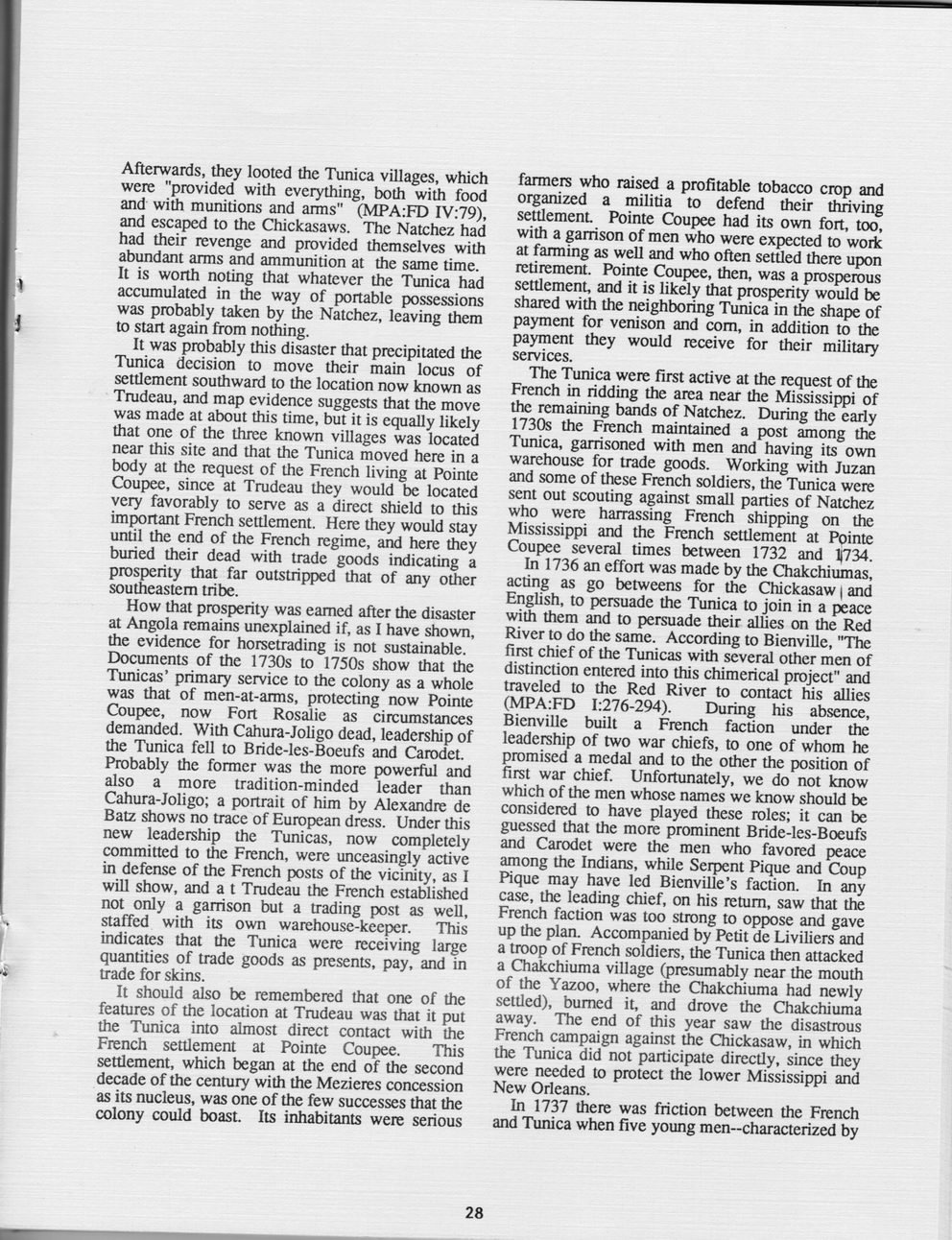This text was obtained via automated optical character recognition.
It has not been edited and may therefore contain several errors.
Afterwards, they looted the Tunica villages, which were "provided with everything, both with food and with munitions and arms" (MPA:FD IV:79), and escaped to the Chickasaws. The Natchez had had their revenge and provided themselves with abundant arms and ammunition at the same time. It is worth noting that whatever the Tunica had accumulated in the way of portable possessions was probably taken by the Natchez, leaving them to start again from nothing. It was probably this disaster that precipitated the Tunica decision to move their main locus of settlement southward to the location now known as Trudeau, and map evidence suggests that the move was made at about this time, but it is equally likely that one of the three known villages was located near this site and that the Tunica moved here in a body at the request of the French living at Pointe Coupee, since at Trudeau they would be located very favorably to serve as a direct shield to this important French settlement. Here they would stay until the end of the French regime, and here they buried their dead with trade goods indicating a prosperity that far outstripped that of any other southeastern tribe. How that prosperity was earned after the disaster at Angola remains unexplained if, as I have shown, the evidence for horsetrading is not sustainable. Documents of the 1730s to 1750s show that the Tunicas’ primary service to the colony as a whole was that of men-at-arms, protecting now Pointe Coupee, now Fort Rosalie as circumstances demanded. With Cahura-Joligo dead, leadership of the Tunica fell to Bride-les-Boeufs and Carodet. Probably the former was the more powerful and also a more tradition-minded leader than Cahura-Joligo; a portrait of him by Alexandre de Batz shows no trace of European dress. Under this new leadership the Tunicas, now completely committed to the French, were unceasingly active in defense of the French posts of the vicinity, as I will show, and a t Trudeau the French established not only a garrison but a trading post as well, staffed with its own warehouse-keeper. This indicates that the Tunica were receiving large quantities of trade goods as presents, pay, and in trade for skins. It should also be remembered that one of the features of the location at Trudeau was that it put the Tunica into almost direct contact with the French settlement at Pointe Coupee. This settlement, which began at the end of the second decade of the century with the Mezieres concession as its nucleus, was one of the few successes that the colony could boast. Its inhabitants were serious farmers who raised a profitable tobacco crop and organized a militia to defend their thriving settlement. Pointe Coupee had its own fort, too, with a garrison of men who were expected to work at farming as well and who often settled there upon retirement. Pointe Coupee, then, was a prosperous settlement, and it is likely that prosperity would be shared with the neighboring Tunica in the shape of payment for venison and com, in addition to the payment they would receive for their military services. The Tunica were first active at the request of the French in ridding the area near the Mississippi of the remaining bands of Natchez. During the early 1730s the French maintained a post among the Tunica, garrisoned with men and having its own warehouse for trade goods. Working with Juzan and some of these French soldiers, the Tunica were sent out scouting against small parties of Natchez who were harrassing French shipping on the Mississippi and the French settlement at Pointe Coupee several times between 1732 and 11734. In 1736 an effort was made by the Chakchiumas, acting as go betweens for the Chickasaw | and English, to persuade the Tunica to join in a peace with them and to persuade their allies on the Red River to do the same. According to Bienville, "The first chief of the Tunicas with several other men of distinction entered into this chimerical project" and traveled to the Red River to contact his allies (MPA:FD 1:276-294). During his absence, Bienville built a French faction under the leadership of two war chiefs, to one of whom he promised a medal and to the other the position of first war chief. Unfortunately, we do not know which of the men whose names we know should be considered to have played these roles; it can be guessed that the more prominent Bride-les-Boeufs and Carodet were the men who favored peace among the Indians, while Serpent Pique and Coup Pique may have led Bienville’s faction. In any case, the leading chief, on his return, saw that the French faction was too strong to oppose and gave up the plan. Accompanied by Petit de Liviliers and a troop of French soldiers, the Tunica then attacked a Chakchiuma village (presumably near the mouth of the Yazoo, where the Chakchiuma had newly settled), burned it, and drove the Chakchiuma away. The end of this year saw the disastrous French campaign against the Chickasaw, in which the Tunica did not participate directly, since they were needed to protect the lower Mississippi and New Orleans. In 1737 there was friction between the French and Tunica when five young men-characterized by 28

Native Americans The-Tunica-Biloxi-Tribe-its-Culture-and-People-(36)